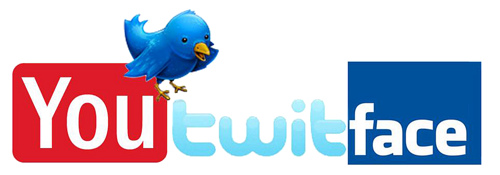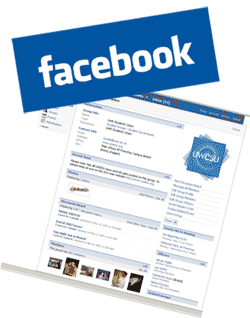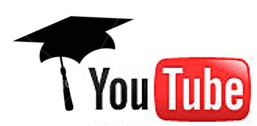
In June last year, Conan O’ Brien predicted that by the year 3000 YouTube, Twitter, and Facebook will merge into “one super time wasting website called YouTwitFace”. Not true 😀 I believe YouTwitFace will become part of the future education system, and teachers will make use of these social websites to impart their knowledge to students.
The speed of how technology grows is unbelievable — it advances with a geometric progression rather than an arithmetical one. One quintessential example would be the Internet. At the birth of the 21st century, the phrase “social media” is alien to most of us. However ten years down the road, social media sites like Facebook, YouTube and Twitter have become part of our daily lives. 72% of Internet users are part of at least one social network, which translates to 940 million users worldwide, according to European research and consulting firm InSites Consulting.
As a 16-Year-Old student, I spend several hours on the net every week to find information on Wikipedia for my school projects, watch Justin Bieber’s music videos on YouTube, and get in touch with my friends on social networking websites Facebook and Twitter. When my forefathers were at their adolescence, they do not even get a chance to use the computer at all, let alone surfing the Internet.
As the Internet continues to proliferate, schools and colleges are also catching up with the trend too. For example, my school has two e-learning days every year. During e-learning days, students need not to go school for lessons, and we attend lessons online on Studywiz, an e-learning platform developed by Etech Group instead. Our teachers would then upload Powerpoint slides or worksheets in Word document onto Studywiz. We have to complete all the tasks given by a certain deadline.
Of course there are advantages and downsides in e-learning. The advanced technology has made completing tasks online much easier and more efficiently, hence precious time will not be wasted. In an unfortunate case of a pandemic like SARS or the H1N1 influenza scare whereby students are required to stay at home, this is when e-learning comes in really handy. Since learning and communicating with students or teachers online do not require any physical interaction, it minimizes the spread of the virus.
On the other side of the coin, schools play an important role in teaching us valuable leadership and communication skills that cannot be learnt on the Internet, according to various studies. Besides that, most of our friends are befriended from schools rather than from strangers on the net.
We have come to a stage where e-learning is very popular in schools all over the world, taking advantage of today’s technologically-advanced world and the large array of resources and tools for educational purposes.
Edinburgh University has gone a step further. In November last year, the university held a ‘virtual graduation ceremony’ for students on its e-learning course who are unable to make the trip to Edinburgh to join in the graduation celebrations with their fellow peers. The university will then broadcast the ceremony at its McEwan Hall on to the Second Life web community.

Students are able to don caps and gowns for their online avatars, receive their hard earned degrees in avatar form, on the college’s virtual campus, and even listen to commencement speakers as they stir graduating seniors’ emotions.
Associate lecturer Fiona Littleton said: “This is the first time this has been attempted at the university.
“Students will be able to download robes and University of Edinburgh hoods for their avatars to wear during the graduation event, and everyone will have free access to a celebratory reception.”
So have you ever wondered what will the future of education be like? Well, I will not be surprised that probably one or two decades later, our future generations will be studying in virtual schools where students attend lessons all on the web. Teachers will then make use of social websites such as Facebook, Twitter and YouTube to engage students in lessons.
Although it is rather ironic to say that schools will embrace social sites into the education system as schools have been banning Facebook and YouTube in the school computers, but there is still a probability that they will use them extensively someday in the near future. Below are some uses and examples of how YouTwitFace can be used in education.
Facebook:
 Despite being a social networking tool mainly for young adults to connect with their friends, co-workers and family members on the Internet by posting updates, uploading photos and videos, Facebook can also become an excellent e-learning platform. By just tweaking some of its technologies and adding new features, teachers can then publish their slides for lessons and lots more multi-media content.
Despite being a social networking tool mainly for young adults to connect with their friends, co-workers and family members on the Internet by posting updates, uploading photos and videos, Facebook can also become an excellent e-learning platform. By just tweaking some of its technologies and adding new features, teachers can then publish their slides for lessons and lots more multi-media content.
Educators can even create useful applications for Facebook that come with better functionalities and features that suit education purposes. For example, they can develop an application that allows students to consult their teachers directly (preferably improving the current built-in Facebook Chat system), hence increasing the efficiency for both students and teachers to interact with one another.
Twitter:
 Twitter is actually an extremely simple platform for friends and co-workers, etc. However, some people even said that it is a fad and practically useless. Just because of that, Twitter has provided us a bigger space for imagination which makes the micro-blogging service become a protocol instead of a platform. As a standard Internet real-time communication protocol, Twitter currently has lots of useful features for education too.
Twitter is actually an extremely simple platform for friends and co-workers, etc. However, some people even said that it is a fad and practically useless. Just because of that, Twitter has provided us a bigger space for imagination which makes the micro-blogging service become a protocol instead of a platform. As a standard Internet real-time communication protocol, Twitter currently has lots of useful features for education too.
Students and teachers are able to send replies or DMs to post questions to teachers, thus suggesting that a real-time two-way communication is happening. As a protocol, an online quiz application can be created based on Twitter. Teachers can send quizzes to students through Twitter and students can answer them via the platform too. This is also known as a new concept for real-time communication.
YouTube:
 As the largest Social Website in the world (According to the Alexa Rank), YouTube, as a video sharing website, plays an important role in enhancing our experience on the Web. Of course, videos can help a lot in education too. The typical usage of videos is to enable teachers to record education-related videos and students are able to watch them on YouTube itself. As a good interactive way of communication, video communication can also be the future of multi-media communication too.
As the largest Social Website in the world (According to the Alexa Rank), YouTube, as a video sharing website, plays an important role in enhancing our experience on the Web. Of course, videos can help a lot in education too. The typical usage of videos is to enable teachers to record education-related videos and students are able to watch them on YouTube itself. As a good interactive way of communication, video communication can also be the future of multi-media communication too.
With comprehensive Rich Media Content, teaching can be much easier, not only the speeches, but also the history references, art resources and many more. Can you imagine how many students would sign up for virtual schools and study online? Well, I am sure the number can exceed 1,000 easily as the efficiency is much higher than the present.
Conclusion:
From the descriptions and examples from YouTwitFace, I believe that you can see what the future of education would look like in the future. We can save lots of time and money, as well as making learning more interesting stuff on the net. Teachers currently have started to use Twitter as a valuable education tool.
Original Powerpoint Slideshow.
But of course there will be some downsides. For example, some teachers may lose their jobs due to low demand of teachers in the future. What’s more is that students may not pay full attention to study but to playing games instead. I am pretty sure that most of you guys especially those in the education field might disagree with what I have described above. We would like to hear your valuable comments below. Thanks.